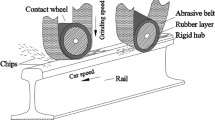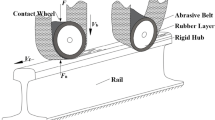Abstract
During the operation of the railway system, various defects that occurred on the rail surface significantly affect the service life of the rail and undermine the stability, safety, and passenger comfort of the train. For this problem, abrasive belt rail grinding (ABRG) has obtained increasingly rapid development for the daily rail maintenance due to the merits of efficient grinding, elastic grinding, and cold grinding. In the process of ABRG, the contact behavior between the abrasive belt and rail is the main factor for material removal. However, current researches on contact behavior concentrated in the contact area and pressure distribution under the static state having ignored the role of dynamic abrasives when considering material deformation. Therefore, this paper proposed a mechanical model of single and multiple grits grinding for ABRG based on local material deformation induced by grit indentation, in which the credibility of the model was verified by the dynamic contact simulation based on the particle hydrodynamics-finite element method (SPH-FEM).















Similar content being viewed by others
References
Cannon DF, Edel KO, Grassie SL, Sawley K (2003) Rail defects: an overview. Fatigue Fract Eng Mater Struct 26(10):865–886
Steenbergen M (2016) Rolling contact fatigue in relation to rail grinding. Wear 356-357:110–121
Vigneashwara P, Wahyu C, Tegoeh T, Gunasekaran P (2017) Predictive modelling and analysis of process parameters on material removal characteristics in abrasive belt grinding process. Appl Sci 7(363):1–17
Vigneashwara P, Wahyu C, Tegoeh T, Hock HT (2018) In-process tool condition monitoring in compliant abrasive belt grinding process using support vector machine and genetic algorithm. J Manuf Process 31:199–213
Wang JW, Xu JJ, Zhang XQ, Ren XK, Song XF, Chen XQ (2018) An investigation of surface corrosion behavior of Inconel 718 after robotic belt grinding. Materials 11(2440):1–14
Wang JW, Xu JJ, Wang XF, Zhang XQ, Song XF, Chen XQ (2019) A comprehensive study on surface integrity of nickel-based superalloy Inconel 718 under robotic belt grinding. Mater Manuf Process 34(1):61–69
Qi JD, Chen B (2019) Elastic-contact-based tool-path planning for free-form surface in belt grinding. Adv Mech Eng 11(1):1–13
Huang Y, Jiahua SL, Xiao GJ, He Y, Dai WT, He S, Li W (2020) Study on the surface topography of the vibration-assisted belt grinding of the pump gear. Int J Adv Manuf Technol 106(11):719–729
Huang Y, He S, Xiao GJ, Li W, Jiahua SL, Wang WX (2020) Effects research on theoretical-modelling based suppression of the contact flutter in blisk belt grinding. J Manuf Process 54:309–317
Xiao GJ, Huang Y (2019) Surface reconstruction of laser-cladding remanufacturing blade using in adaptive belt grinding. Int J Adv Manuf Technol 101(9–12):3199–3211
Eric EM, Joseph K (2002) The application of contact mechanics to rail profile design and rail grinding. Wear 253(1):308–316
Fan WG, Liu YM, Li JY (2018) Development status and prospect of rail grinding technology for high speed railway. Chin J Mech Eng 54(22):184–193
Real JI, Zamorano C, Velarte JL, Blanco AE (2015) Development of a vehicle–track interaction model to predict the vibratory benefits of rail grinding in the time domain. J Mod Transport 23(3):189–201
Wang WX, Li JY, Fan WG, Hou GY (2019) A numerical model to investigate contact status for rail grinding by abrasive belt with an axial deflection. J Braz Soc Mech Sci 41(11):1–10
Wang WX, Li JY, Fan WG (2019) Investigation into static contact behavior in belt rail grinding using a concave contact wheel. Int J Adv Manuf Technol 101(9):2825–2835
Fan WG, Liu YM, Wang WX, Li JY, Wang RQ (2018) Research on modeling method of material removal for rail grinding by abrasive belt based on elastic Hertzian contact. Chin J Mech Eng 54(15):191–198
Fan WG, Wang WX, Hou GY, Wang XH (2020) Macro contact pressure modeling and simulation for rail grinding with abrasive belt based on curvature match. Chin J Mech Eng 56(2):154–162
Fan WG, Liu YM, Song XY, Cheng JF, Li JY (2018) Influencing mechanism of rubber wheel on contact pressure and metal removal in corrugated rail grinding by abrasive belt. J Manuf Sci E-T ASME 140(12):1–8
Wang WX, Li JY, Fan WG, Song XY, Wang LF (2017) Characteristic quantitative evaluation and stochastic modeling of surface topography for zirconia alumina abrasive belt. Int J Adv Manuf Technol 89(9–12):3059–3069
Fernandes LM, Lopes JC, Ribeiro FSF, Gallo R, Razuk HC, Sanchez LEA, Aguiar PR, Mello HJ, Bianchi EC (2019) Thermal model for surface grinding application. Int J Adv Manuf Technol 104(5–8):2783–2793
Sato BK, Rodriguez RL, Talon AG, Lopes JC, Mello HJ, Aguiar PR, Bianchi EC (2019) Grinding performance of AISI D6 steel using CBN wheel vitrified and resinoid bonded. Int J Adv Manuf Technol 105(5–6):2167–2182
Lopes JC, Fragoso KM, Garcia MV, Ribeiro FSF, Francelin AP, Sanchez LEA, Rodrigues AR, Mello HJ, Aguiar PR, Bianchi EC (2019) Behavior of hardened steel grinding using MQL under cold air and MQL CBN wheel cleaning. Int J Adv Manuf Technol 105(5–8):4373–4387
Gao KY, Chen HB, Zhang XQ, Ren XK, Chen JQ, Chen XQ (2019) A novel material removal prediction method based on acoustic sensing and ensemble XGBoost learning algorithm for robotic belt grinding of Inconel 718. Int J Adv Manuf Technol 105(1–4):217–232
Zhang XQ, Chen HB, Xu JJ, Song XF, Wang JW, Chen XQ (2018) A novel sound-based belt condition monitoring method for robotic grinding using optimally pruned extreme learning machine. J Mater Process Technol 260:9–19
Chen JQ, Chen HB, Xu JJ, Wang JW, Zhang XQ, Chen XQ (2018) Acoustic signal-based tool condition monitoring in belt grinding of nickel-based superalloys using RF classifier and MLR algorithm. Int J Adv Manuf Technol 98(1–4):859–872
Zhang SY, Zhou K, Ding HH, Guo J, Liu QY, Wang WJ (2018) Effects of grinding passes and direction on material removal behaviours in the rail grinding process. Materials 11(11):2293
Shang W, Wang WJ, Guo J (2016) Simulation of single-grind grinding of rail grinding based on SPH method. Dia & Abra Eng 36(3):54–59
Acknowledgments
The authors would like to thank the financial support from the Fundamental Research Funds for the Central Universities (Grant No. 2019JBM050).
Author information
Authors and Affiliations
Corresponding author
Additional information
Publisher’s note
Springer Nature remains neutral with regard to jurisdictional claims in published maps and institutional affiliations.
Rights and permissions
About this article
Cite this article
Fan, W., Wang, J., Cheng, J. et al. Dynamic contact modeling considering local material deformation by grit indentation for abrasive belt rail grinding. Int J Adv Manuf Technol 108, 2165–2176 (2020). https://doi.org/10.1007/s00170-020-05553-x
Received:
Accepted:
Published:
Issue Date:
DOI: https://doi.org/10.1007/s00170-020-05553-x




